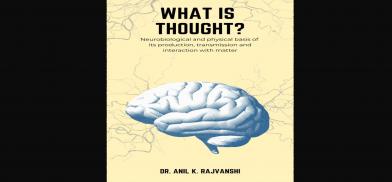Knowledge Gain via Quantum Entanglement
All great discoveries of the world like Einstein’s gravitation theory, Newton’s theory of light, gravity, motion, great music of Beethoven, Mozart among others, and the knowledge of Universe by sages and scientists has been obtained by this process.

In my recent book: What is Thought? I have defined thought as a hologram which is produced via photons emitted in the synaptic cleft. Synaptic cleft is extremely small (20 nano-meter) region between the neurons where one neuron talks with the other neuron by exchanging neurotransmitters (NT). These NT are chemicals which are exchanged between neurons and once exchanged they get converted into electrical signals inside the neuron for onward journey.
Large number of such neuron interactions produce neural pathways. And each set of such neural pathways is responsible for thought production of a particular object.
During this exchange of neurotransmitters, weak photons (also called biophotons) are produced at each synaptic cleft. Synchronization of millions and millions of such synaptic cleft photons produce a hologram which we can call thought.
Most of these holograms are continuously produced in the brain. When focus is not there they also fade immediately. This is what is called brain chatter and is the genesis of attention deficit hyperactivity disorder (ADHD).
A concentrated thought hologram
However, a concentrated thought hologram which according to Sage Patanjali results in 'Sanyam' (concentration, focus and Samadhi) has enough energy for it to be transmitted out of the brain (leaky thoughts!).
These powerful thoughts also affect people who come in the presence of such beings and are the cause of aura or evil presence that many people have reported with such interaction.
Besides such interaction, this thought hologram also interacts with the object or the subject of our interest and results in getting its knowledge.
How does this interaction take place and more importantly how this knowledge is received by our brain. For objects that we can see and feel it is quite easy because our senses guide the thought hologram in doing so. But for the concepts and subjects that we do not see and are beyond our reach what is the mechanism? The science of quantum entanglement may provide a possible answer.
Quantum entanglement of thought
Quantum entanglement (Spooky action at a distance as Einstein described it) is a concept which states that photons or even particles created or generated are entangled with each other in such a manner that the knowledge of one can describe the other, no matter how far apart they are.
We can conjecture that our concentrated thought hologram that leaks out of the brain and interacts with the object or subject of our interest, somehow changes the property of the hologram in the brain via the entanglement process.
This continuous exchange of information by the process of quantum entanglement allows the idea and the reality to match in an induced-fit arrangement and thus the knowledge is perceived.
The induced-fit model is used in drug design and is based on the hypothesis that the drug binds to the active site and in the process of binding, changes the shape of the active site so as to have precise fit. This enhances the drug action.
I conjecture that the same action of induced fit may be taking place in the hologram interaction with the object of interest, which in turn affects the hologram in the brain. Sage Patanjali has also alluded in his Yoga Sutras to this mechanism for knowledge gain.
All great discoveries of the world like Einstein’s gravitation theory, Newton’s theory of light, gravity, motion, great music of Beethoven, Mozart among others, and the knowledge of Universe by sages and scientists has been obtained by this process. When our senses do not feel and guide the thoughts and yet the knowledge is perceived, then it can only happen with the process of quantum entanglement of thought.
(The writer, an IIT and US-educated Indian engineer, a 2022 Padma Shri award winner, is the Director, Nimbkar Agricultural Research Institute, Phaltan, Maharashtra. He can be reached at anilrajvanshi50@gmail.com)









Post a Comment